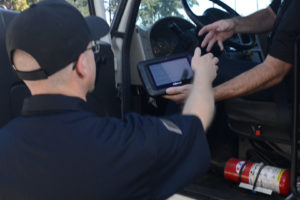The Commercial Vehicle Safety Alliance’s (CVSA) Brake Safety Week occurs every August. Thousands of mechanical fitness roadside inspections on commercial motor vehicles (CMVs) are conducted to identify and remove vehicles with critical brake violations from our roadways.
The goal: save lives by reducing crashes.
Commercial motor vehicle (CMV) inspectors throughout North America conducted 38,117 inspections of CMVs in August of 2022. 13.3 percent were placed out of service for brake-related critical vehicle inspection violations, while 86.7 percent of inspected CMVs did not have these violations. Nearly one in seven (or some 5,000) CMVs had to be pulled from the road because of violations that could easily have been avoided through proper inspection and maintenance.
FMCSA’s 2022 Pocket Guide to Large Truck and Bus Statistics reports that “Out of Adjustment Brake Violations” were the third most frequent violation. Inspectors reported 128,376 violations out of 1,962,737 inspections, or 6.5 percent. However, there were another 247,238 other types of brake violations, bringing the total to 375,614. That’s just over 19 percent.
There is no reason why one in five CMVs should have brake issues.
There is no reason to become an OOS statistic.
Here’s how to avoid that fate.
First, Repairs and defects that lead to inspection violations are preventable with Zonar EVIR®—the only patented, verifiable, electronic inspection system on the market today.
Then, be prepared for Brake Safety Week, which will be August 20 – 26, 2023.
Inspectors will primarily conduct the North American Standard Level I Inspection with a focus on brake hoses/tubingwhich is part of a 37-step procedure that includes an examination of both driver operating requirements and vehicle mechanical fitness. Inspections conducted will include inspection of brake-system components with attention to eight specific features:
- Checking the air brake mechanical components
- Checking the steering axle air brake mechanical components
- Checking the brake adjustment
- Building the air system’s pressure to 90-100 psi
- Checking the antilock braking system (ABS) if applicable
- Testing the air loss rate, if necessary
- Testing the low air pressure warning device
- Checking the tractor protection system
Remember: The minimum braking efficiency for trucks is 43.5 percent, required by U.S. federal regulation and the CVSA out-of-service criteria.
The cost of an asset being placed out of service is substantial. There’s the hit from what is effectively an emergency roadside service call. Add in the delay of that specific load delivery, particularly if it is time-sensitive or carrying perishables. Then add in the cost of any disruption to the rest of the operation by having an asset sidelined. There may be additional expense risks. Insurance premiums may be affected. There may be a loss of business or reduced contract rates due to poor CSA scores.
In the worst case scenario, should a driver cause an accident due to a maintenance violation, juries won’t look kindly on a carrier that has multiple violations in its past.
Don’t become an OOS statistic. Be ready for Brake Safety Week and use EVIR.







